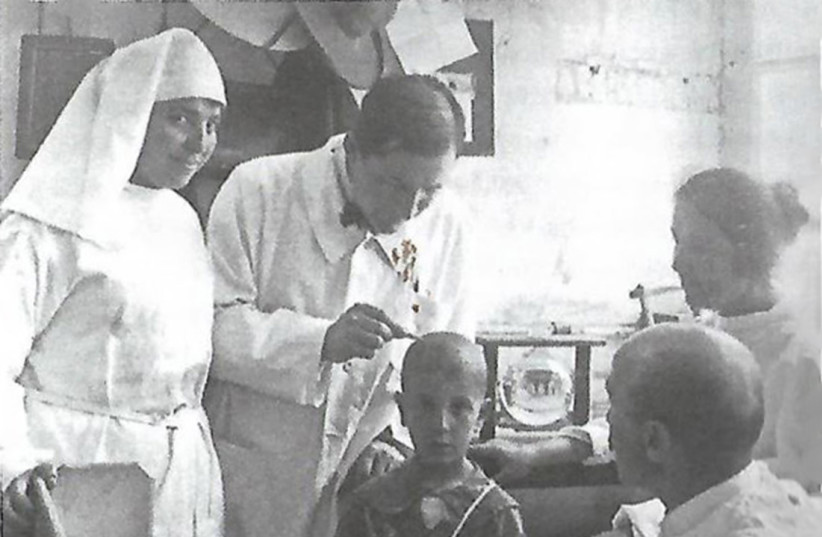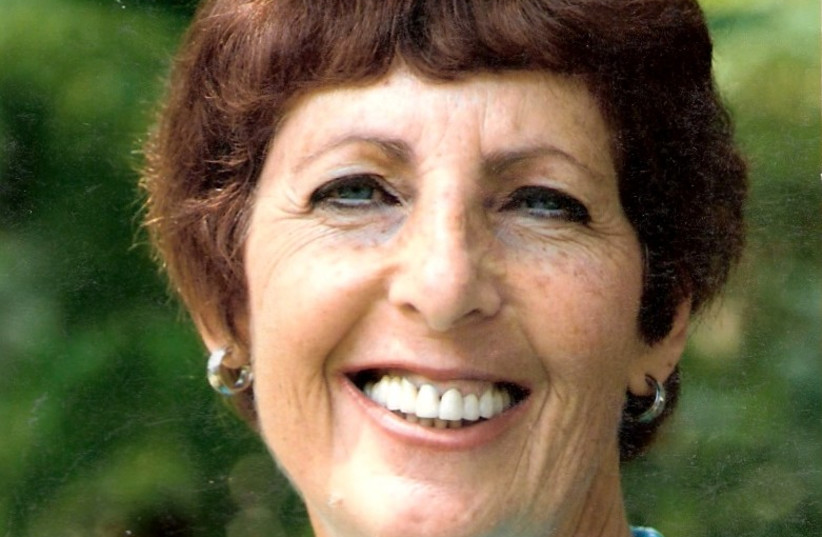‘Primum non nocere” – the Latin phrase meaning “First, do no harm” – is a principal precept of bioethics that all healthcare students are taught.
But this tenet was violated in the early 20th century until about 60 years ago by reputable doctors, nurses, X-ray technicians, hospitals and health maintenance organizations around the world, including in France, England, Portugal, Yugoslavia, Poland, pre-1948 Palestine and the State of Israel after the arrival of multitudes of new immigrants.
The precept was not applied by ionizing irradiation of the heads of children diagnosed with ringworm, tinea capitis (TC) – a contagious but not deadly skin fungus resulting in a red, itchy, scaly, circular rash that, decades later, was found to have caused thyroid and head and neck cancers from around age 60 in many of those who underwent the X-ray procedure.
“It was not an experiment on a certain population, but even doctors can make mistakes.”
Prof. Shifra Shvarts
<br>Treating ringworm
Before X-rays were discovered by Conrad Roentgen in 1895 and suggested after the turn of the century by doctors for CT, young children suffered horribly by affected hairs being plucked out with forceps from the scalp, covered with plasters or grease made from black pitch, gum arabic, potassium and other substances, and heads swathed with cloth. The manual epilation was painful, time-consuming and impractical, and the bald children were ridiculed, isolated, kept out of school for months or years and disfigured. Many photos taken in Europe and Israel arouse sympathy and even horror.
But those who performed such “therapy” cannot be blamed. Irradiation successfully treated the fungus, and those who ordered and performed it couldn’t have known about the severe aftereffects decades later from the X-rays, which were regarded for a long time as a “miraculous” treatment.

Millions of young children around the world, including 30,000 Jewish children here between 1925 and 1960, underwent irradiation for ringworm at the Sha’ar Ha’aliyah immigrants’ transit camp near Haifa and in Sheba and Hadassah hospitals; Arab children at a center in Nazareth established by the Health Ministry; and youngsters irradiated by private doctors in an arrangement with the ministry and the health funds.
<br><br>Compensation for victims
In 1994, the Knesset passed legislation giving financial compensation to victims who suffered health problems that were connected to the irradiation they underwent as children in immigrant camps in Europe and in North Africa before their aliyah. A total of 30,000 people received compensation for irradiation they had between 1946 and 1960.
X-ray treatment of the scalp was finally abandoned after clinical trials on griseofulvin, a salve that became the definitive and safe treatment for TC, two decades after it was first discovered.
The same catastrophic medical practice involved thalidomide, a non-prescription drug that was developed in the 1950s by the West German pharmaceutical company Chemie Grünenthal, which was originally intended as a sedative or tranquilizer but was soon used for treating a wide range of other conditions, including colds, flu, nausea and morning sickness in pregnant women. Scientists were ignorant of the fact that the effects of a drug – which was not tested on pregnant women – could be passed through the placental barrier and harm a fetus in the womb.
It’s estimated that more than 10,000 babies around the world were affected by the drug, half of them dying within months of birth and many others being born without arms. It took five years for the connection to be made between thalidomide taken by pregnant women and the impact on their children. The pharmaceutical company was brought to trial and the case was settled out of court, with financial compensation made to German and British victims; no one was found guilty of any crimes.

Another famous case of harm from medicine was that of Rose Marie Kennedy, the eldest daughter born to Joseph P. Kennedy Sr. and Rose Fitzgerald Kennedy and a sister of US president John F. Kennedy and senators Robert F. and Edward Kennedy, who in her early young adult years suffered seizures and violent mood swings. Her father was advised by doctors that she undergo a prefrontal lobotomy – a removal of part of her brain. The surgery at age 23 left her permanently incapacitated and rendered her unable to speak intelligibly.
Even today, some 100,000 Americans die every year from addiction to narcotic painkillers after surgery and to treat cancer pain that were prescribed by doctors who didn’t know they were addictive.
THE TC catastrophe has now been documented in a monumental new English-language, 366-page volume, Ringworm and Irradiation, written and edited by pioneering Ben-Gurion University Faculty of Health Sciences’ medical historian Prof. (emeritus) Shifra Shvarts with Prof. Siegal Sadetzki-Jackobson of the Gertner Institute for Epidemiology and Health Policy Research at Tel Aviv University’s Sackler Faculty of Medicine. A former head of public health at the Health Ministry during the COVID-19 pandemic, Sadetzki-Jackobson was principal national investigator for the tinea capitis research project at Gertner.
Chapters written by 20 experts in Israel, the US, Portugal, England, Canada, Serbia and France offer details on how TC was treated in those countries.
They edited a Hebrew version titled “Gazezet,” released by BGU in 2018. It took a decade to collect the evidence on TC treatments and their effects and produce the books, which are embellished and authenticated by more than a thousand footnotes.
“On first glance at the title, most non-medical individuals would not bother reading a book with such a title,” commented Prof. Shimon Glick, a valued mentor of Shvarts, a founder of BGU’s Faculty of Health Sciences and former head of Soroka-University Medical Center’s Internal Medicine Department. “But in doing so, they would be missing a fascinating adventure. The story is about a common disease going back to ancient Egypt, with widespread victims in many societies. While not a life-threatening disease, it affected innumerable patients with severe cosmetic damage and adverse social consequences.”
The cause of the disease was first understood as a fungus infection in the 19th century, Glick said in an interview, but the treatments were disfiguring and most unsatisfactory. When X-rays were discovered at the turn of the 20th century, and its effectiveness shown, widespread use was made of this modality in many countries. But only years later were the long-term serious side effects discovered. Thereupon, huge public health measures were put into effect to find all those individuals that had been X-rayed and provide diagnosis and treatment of the side effects of the therapy.
“But aside from the public health, diagnostic and therapeutic aspects of these side effects there were important social, economic and legal aspects to these events. For example, how to find all the treated patients, compensation for damages, lawsuits against the institutions that administered these treatments, and other implications. Much of the research in these areas was done in Israel, where thousands of new immigrants were treated by scalp radiation and had very good data. The medical people definitely acted with the best medical standards at the time.”
The book, he continued, “discusses the implications of treatments given according to the best understandings of the times, but which turned out to be harmful; the role of governments; and many other relevant issues. There were all kinds of considerations about hiding the news about side effects, exaggerations by journalists and lawyers of patients who wanted to sue and deniers of responsibility, as you might expect from lawyers and politicians.”
The volume “also describes the actions of other countries in their handling of the issues. Each chapter is free standing and can be read in isolation – written by experts in the field, constituting a thought-provoking and educational masterpiece,” said Glick.
The documentation was the initiative of Prof. Mordechai Shani, an expert in healthcare systems and a specialist in internal medicine at TAU who served for 33 years as director-general of Sheba Medical Center and was twice director-general of the Health Ministry.
SHVARTS SAID she was assisted by colleagues abroad who are members of the International Society for Historic Medicine, of which she was deputy director-general and vice president.
“Treatment of TC, which was passed head to head like head lice, wasn’t the only failure of organized medicine that used X-rays for treatment. There were children who were irradiated for acne and other conditions and developed tumors,” she said in an interview.
One of the Israeli medical heroes in the book is Prof. Baruch Modan, who was director of the Health Ministry and initiated legislation to require reporting of cancer cases. This helped connect the irradiation of immigrant children, most from North Africa and Asia who later developed tumors, to the TC treatment. Local Arab children also underwent X-rays for ringworm.
TC trauma
Shvarts said the treatment wasn’t aimed against any specific population.
“Irradiation was acceptable in the world from 1910,” Shvarts asserted. “It was first done in France, then England, Portugal, Yugoslavia and Israel. The largest numbers of children were in France and the US. “
After irradiation with metal devices on their heads, the hair fell out, but it returned in 90% of the children, she noted.
“Today, such children would have been given psychological treatment for what they endured; I don’t know of any studies on post-trauma resulting from TC and the irradiation.”
One victim, X., recalled: “Baldness that robbed me of my children, my smile, my happiness. Baldness that prevented me from running in the street and playing like every other child. ‘She’s bald!’ The calls of the children still resonated in my tormented head. Baldness that caused my family such numerous expenses and despite difficulties making a livelihood; they bought me a wig so I could look better. This didn’t prevent the fear and anxiety of ‘What will become of me?’” X has been bald since childhood as the result of ringworm irradiation treatment in the 1950s.
C.H. of Portugal recalled in the book: “I was irradiated at age four. Although I was small, I remember everything. I feel that as a result of the disease, my life changed and I never had a healthy life. When I would complain to my mother that I didn’t feel well, she didn’t care and would even hit me. I always had difficulty in crowds of people, difficulties finding work. I kept to myself the feeling of disgust that only I can understand.”
Nelly of Eastern Europe, whose mother died in 1984, testified: “My uncle, my father’s brother who is also my mother’s cousin died two years ago. Both had meningioma, which is a benign brain tumor. Both had radiotherapy for ringworm as children.”
D. from Algiers also shared his pain.
“At the time, they told me I had a sore here [pointing to her head], and I need to be there. They shaved off all my hair and I was left bald. I remember they were putting iodine and a kind of bandage and every morning they shampooed our heads. They spread on the iodine and then they did with the machine... You sit and some kind of machine goes zzzzzz on your head, and you’re forbidden to move, to move a muscle. I was 13 years old,”
One of the lessons of the book, Shvarts concluded, is that physicians and researchers must be careful when they look for solutions to human suffering. No one in this catastrophe was to blame, but no one – no politicians or lawyers or journalists – should take advantage of such a situation.
“It was not an experiment on a certain population, but even doctors can make mistakes.”
